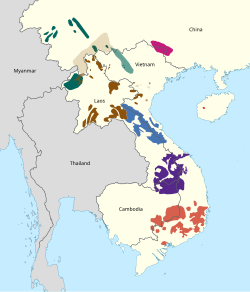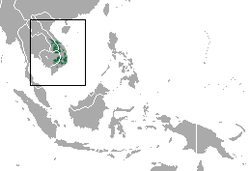| Nomascus | |
|---|---|
 | |
| Northern white-cheeked gibbon Nomascus leucogenys | |
| Scientific classification | |
| Kingdom: | Animalia |
| Phylum: | Chordata |
| Class: | Mammalia |
| Order: | Primates |
| Family: | Hylobatidae |
| Genus: | Nomascus Miller, 1933 |
| Type species | |
| Hylobates leucogenys Ogilby, 1840 | |
| Species | |
Nomascus concolor Contents | |
 | |
| Map showing the distribution of Nomascus species Nomascus leucogenys - Extant
Nomascus concolor - Extant
Nomascus nasutus - Extant Nomascus siki - Extant Nomascus hainanus - Extant Nomascus annamensis - Extant Nomascus gabriellae - Extant | |
Nomascus is the second-most speciose genus of the gibbon family, Hylobatidae. Originally, this genus was a subgenus of Hylobates, with all individuals considered to be one species, H. concolor.
Species within Nomascus are characterized by 52 chromosomes. Some species are all-black, some are a lighter beige or peach hue, with a distinct black tuft of crown fur, while others have notable, light-colored cheek “patches”. Nomascus is endemic from southern China (Yunnan) to southern Vietnam, and can also be found on Hainan. Every species within this genus are either endangered or critically endangered; the Eastern black crested gibbon (Nomascus nasutus) has been deemed "the most-critically endangered ape species in the world". [1]















